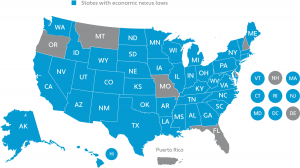On September 27, 2010, President Obama signed the Small Business Jobs and Credit Act of 2010 (“Jobs and Credit Act”) into law. (See my AllBusiness.com October 4, 2010 post, “Small Business Jobs and Credit Act of 2010 Includes Beneficial Tax Provisions to Fuel Business Growth”, in which I explained several of the tax provisions that were part of the Jobs and Credit Act.)
One of the most significant tax provisions included in the Jobs and Credit Act was the extension of the fifty percent (50%) first-year special depreciation allowance provision, commonly referred to as “bonus depreciation”. The Jobs and Credit Act extended the first-year bonus depreciation provision, which had expired at the end of 2009, through December 31, 2010 and made the provision retroactive to January 1, 2010. The Jobs and Credit Act also extended the bonus depreciation provision through 2011 for property with a 10 year or longer recovery period, such as certain long-lived assets and transportation property. (The bonus depreciation provision along with the increase in the Section 179 expensing deduction, are arguably, the two most significant tax provisions in the Jobs and Credit Act as these provisions together have the potential to create significant federal tax deductions for taxpayers who make capital investments in qualifying property.)
History of Federal Bonus Depreciation
Just in case you’re wondering, bonus depreciation has been around for a few years. It first became viable as part of the Job Creation and Worker Assistance Act of 2002. Initially, the deduction was limited to 30% of the cost of “qualifying property” purchased between September 10, 2001 and September 10, 2004, and placed in service before January 1, 2005. The bonus depreciation limitation was increased from 30% to 50% for assets purchased after May 5, 2003 and before January 1, 2005 with the enactment of the Jobs and Growth Tax Relief Reconciliation Act of 2003. Following a three year period (1/1/05 through 12/31/07) during which the provision was not in effect, the 50% first-year bonus depreciation deduction was reinstated as part of the 2008 Economic Stimulus Act. The 2008 Act applied to “qualifying property” placed in service after December 31, 2007 and before January 1, 2009. The following year, 2009, the 50% bonus depreciation deduction was extended through the end of 2009 by the American Recovery and Reinvestment Act of 2009. Finally, in 2010, the first-year federal bonus depreciation that had expired at the end of 2009 was once again extended through December 31, 2010 and made retroactive to January 1, 2010 with the Small Business Jobs and Credit Act of 2010.
State Conformity to the Federal Bonus Depreciation Provision
Although the federal tax law has allowed a first-year bonus depreciation deduction of up to 30%, and later 50%, during most of the years since 2002, many states do not allow the same generous first-year depreciation deduction to enter into their state’s taxable income calculation. Although a taxpayer may be able to significantly decrease his federal tax liability by claiming bonus depreciation on purchases of “qualifying property”, the same benefit might not be available on a taxpayer’s state tax return.
I’ll illustrate with a high-level explanation of how this works for state corporate tax computation purposes. In general, when a corporation calculates its state taxable income, its starting point is the corporation’s federal taxable income. Depending on the state, this would be either line 28, before federal net operating loss, or line 30, after federal net operating loss, on federal Form 1120. This amount is then increased or decreased by amounts which represent income or expense items which are treated differently for state tax purposes than they are for federal tax purposes. This is similar to the concept of how some income/expense items are treated differently for financial accounting purposes, versus how these same items are required to be reported on a taxpayer’s return by the Internal Revenue Code. Those states that do not allow federal bonus depreciation to decrease state taxable income require that a taxpayer “add-back” the federal bonus depreciation deduction to arrive at state taxable income. Some states require that only a portion of the first-year bonus depreciation be added back, with some additional modifications. Minnesota, for instance, allows taxpayers to deduct 20% (instead of 50%) of the federal bonus depreciation in the first year, with the remaining 80% deducted evenly over the next five years. However, this does not mean that a state which disallows federal bonus depreciation completely disallows any type of state depreciation deduction. The state will still allow the same asset to be depreciated over the asset’s useful (i.e., depreciable) life for state tax computation purposes; but at a much less aggressive rate. For instance, a state may follow the regular federal depreciation method for that asset, which may allow for some acceleration (more depreciation taken in the earlier years). Or, a state may allow or require another depreciation method, such as straight-line (evenly) over the asset’s life. At the end of the day, or should I say, at the end of the asset’s useful life, the total depreciable cost of an asset will have been deducted on both the corporation’s federal and state corporate income tax return.
But if the total amount of depreciation deducted over the asset’s life is the same for federal and state tax purposes, why is it then, that some states disallow the federal bonus depreciation deduction in the first year?
A couple of reasons why states disallow the federal bonus depreciation deduction are either because the state has explicitly “decoupled” from the federal bonus depreciation provision, or because the state does not follow the most updated version of the Internal Revenue Code (“IRC”). An example of the latter would be a state that follows the IRC as of a fixed date in an earlier year. For instance, a particular state’s law may conform to the IRC as of December 31, 2000. Since federal bonus depreciation did not exist on December 31, 2000, that particular state would not follow the current federal rules.
Other states might enact conforming legislation to adopt the most recent federal tax law changes, but might specifically “decouple” from the bonus depreciation provision. Even states who have what is known as “rolling conformity”, which means that the state law is written in such a manner that state law immediately conforms to any new federal tax law changes, might choose to “decouple” from the federal bonus depreciation provision. In general, states haven’t been eager to fully embrace the generous federal bonus depreciation deduction as they are ill prepared to deal with the negative impact on state revenues. With many states experiencing huge deficits in the last few years, it seems likely that many states may choose not to conform to the latest bonus depreciation extension allowed under the Jobs and Credit Act, even if they adopt the other provisions in the Act. (For more insight on how bonus depreciation has impacted state revenues, see “Bonus Depreciation, Bonus Headaches”, published in Forbes.com on 3/5/08, and, “New Federal Law Could Worsen State Budget Problems, States Can Protect Revenues by Decoupling”, published by the Center on Budget Policy and Priorities on 2/28/08)
You’re probably wondering where your particular state stands on federal bonus depreciation conformity.
Some states such as Massachusetts and Illinois have “rolling conformity”, which means that their state law is typically written to incorporate any new federal tax law changes. But as noted above, even states with “rolling conformity” can choose to pass decoupling legislation. Certain other states that do not have “rolling conformity”, such as Indiana and West Virginia, will frequently pass conforming legislation that adopts the newest changes to the IRC. And other states, such as California and Texas, do not regularly update their conformity, which means they do not follow current year or even recent year federal changes. If you want to get an idea of where your state stands on federal bonus depreciation conformity, search your state’s Department of Revenue (Taxation) website. You can easily get to your state’s taxation department by visiting my State Tax Department Links webpage here at The State and Local Tax “Buzz” (you can also get to the State Tax Department page via the tabs above). Once you are in the state website, try using “bonus depreciation” or “IRC conformity” as search terms – both with and without quotes – or contact the state tax agency by phone.
Sylvia’s Summation
While taxpayers have the ability to substantially decrease their 2010 (and possibly 2011) federal tax liability by taking advantage of the 50% first-year federal bonus depreciation deduction that was reinstated as part of the Jobs and Credit Act, taxpayers will not necessarily receive the same benefit on their state tax returns. This is because states either do not follow a current version of the IRC, or have explicitly chosen to “decoupled” from this provision of the federal law, thus disallowing this deduction from entering into the calculation of state taxable income. With states still recovering from their fiscal woes of these last two years, it seems likely that many states will decouple from the latest bonus depreciation extension. It is also very important to note, that although the focus of this post is on bonus depreciation, the same can be said of the Section 179 expense deduction provision. That is, although states are more likely to decouple from the bonus depreciation provision than they are the Section 179 expensing provision, there are also many states that do not allow or have decoupled from federal Section 179. As always, it is important for readers to consult their CPA or tax advisor to gain a complete understanding of how these tax provisions apply to their specific tax situation.
The above post was authored by Sylvia F. Dion, and initially published in Allbusiness.com. on November 8, 2010. It has been reproduced, with a few modifications, as a post for The State and Local Tax “Buzz” for the benefit of readers of this blog. For more on my contributions to AllBusiness.com, see sidebar “Read My Posts at AllBusiness.com”.






